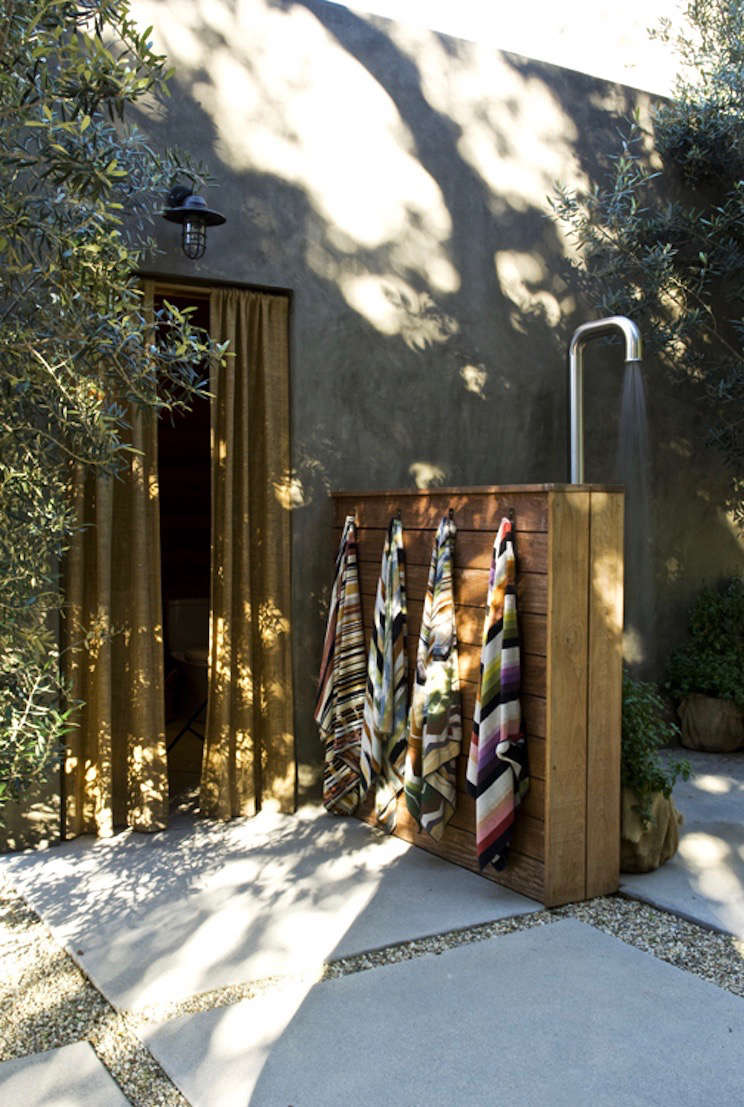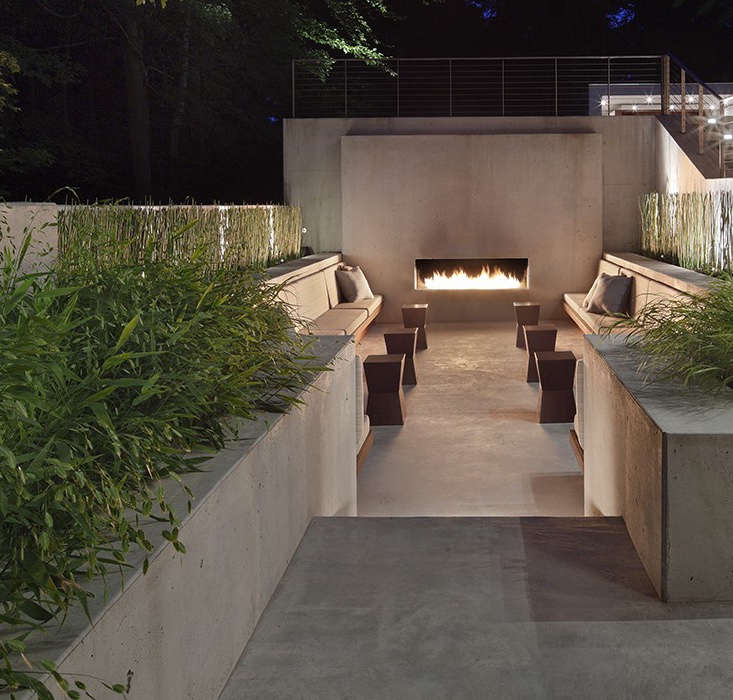As a landscape designer in Northern California for more than 15 years, I often find myself talking about the importance of “good bones”—the important design concept of strong structure to make a garden space grounded and attractive year round.
While plants can provide some of this framework, I prefer to use elements that remain even after the flowers and leaves blow away. I am talking about structures such as walls, patios, and planters. And one of the best ways to create durable and versatile hardscape elements is with poured-in-place concrete.
What is poured-in-place concrete and why do I need it?
Above: Poured-in-place concrete creates built-in seating in a California garden. Photograph by Michele Lee Willson courtesy of Arterra Landscape Architects.
Poured-in-place concrete (or sometimes called cast-in-place concrete) is a type of building material that is poured into forms where it will set, be finished and remain almost permanently. Whether your taste and style of house leans toward modern or classic, poured-in-place concrete is a versatile miracle worker because it can fit into most styles. Also, if you are looking to create strong forms that create “rooms,” divide and link spaces, and/or provide architectural interest, this is your material.
What type of elements can you create with poured-in-place concrete?
Above: Photograph courtesy of Alexander Designs.
The question is almost what can’t you create? With poured-in-place concrete, you can build many different types of customs elements including patios, pathways, stairs, benches, fire pits, driveways, water features, retaining walls, planters, and lawn edging. Because the possibilities seem so great, it is best to start digging around (sorry) on garden websites to collect ideas.
My top picks for poured-in-place concrete elements:
Above: Concrete planters are home to a variety of shade plants. See more in Landscape Architect Visit: Scott Lewis Turns a Small SF Backyard Into an Urban Oasis. Photograph courtesy of Scott Lewis Landscape Architecture.
Raised planters. A raised concrete planter can give you a clean structure as well as being surprisingly multi-functional. For example, a planter with a wide edge provides the perfect sitting spot or an easy place to rest while tending and harvesting flowers or vegetables.
Walls with a friend. A concrete wall with a wooden bench seat, fire pit, or water feature attached can make a modern statement and provide good structure to the landscape. Design tip: By creating many landscape elements with one cohesive material, like poured-in-place concrete, you can enhance continuity and flow and eliminate the possible mishmash.
Above: Specht Harpman Architects (now Specht Architects) won a 2013 Gardenista Design Award for a landscape created in collaboration with Gunn Landscape Architecture. See more in Best Architectural Garden Feature.
How do you pour concrete?
As the name suggests, liquid concrete is poured into molds or forms made to the design specifications, including depth, width, and height. Without getting into the nitty gritty details, the basics are: in general, plywood, and steel forms are set and secured in place. Before the concrete is poured into the form (as in the case of walls), the contractor digs and pours a footing to act as a foundation for the wall. Rebar will be included for extra strength and durability.
Above: Poured concrete steps in a landscape by Pedersen Associates, members of our Architect and Designer directory.
Applying mainly to retaining walls again, it’s necessary to install weep holes to allow water to escape, (concrete is an impervious material). Or a drainage system needs to be installed to divert water, to lessen hydrostatic pressure. Let me say that this term alone should be a major clue that poured-in-place concrete is not a good DIY project and should be left to the pros. Also, major and costly mistakes can occur if the setup isn’t correct. Concrete, unfortunately, is not very forgiving.
After the setup is complete, concrete is finally poured between the forms. Then after the concrete sets and dries, the forms are dismantled and a skilled concrete craftsman can add patterns or stains if you want a certain look.
Above: Garden Designer Naomi Sanders added a walkway of cast concrete pavers to match an existing concrete stoop in Before & After: A Grande Dame in LA’s Hancock Park. Photograph by Jennifer Roper.
When do I need a concrete truck parked in front of my house?
Basically, anything over one cubic yard should be pumped in by a truck and not mixed by hand or in a standing mixer. When you have a large project or there are many elements to be poured, you want consistency of product. What I mean is that when you use bagged concrete there is a risk of each batch being different, whereas a concrete truck delivers a uniform mix.
Above: A poured in place concrete bench in the garden of the Glassell Boathouse in LA (available to rent on Airbnb). For more, see A Budget Renovation for a Stylish LA Guesthouse on Remodelista.
How much does poured-in-place concrete cost?
The cost to build with poured-in-place concrete can range from about $65 to $110 per square face foot, depending on the site conditions and design specifications. (Here’s a little nitty detail…or maybe it’s more gritty, but square face foot is a unit of measurement used by masons and contractors to calculate how many square feet of visible wall there is, regardless of depth.)
The price is likely to be higher for an extra deep wall or a structure with elaborate curves and tricky angels. And speaking of higher prices, pumped in concrete can run you about $250 a cubic yard, but as we learned above, some times you need to get your concrete pumped in even though it is more expensive.
Above: A concrete trough fountain sits in a gravel bed in landscape architect Christine Ten Eyck’s Austin, Texas backyard. See more in Gardenista: The Definitive Guide to Stylish Outdoor Spaces. Photograph by Matthew Williams.
Poured-in-Place Concrete Recap
Above: Photograph courtesy of Urban Organics Design.
Pros:
• Almost Herculean strength, able to hold back tons of earth and water, making it a solid choice for retaining walls.
•Rot proof, fireproof, durable, and will last for decades if properly installed.
• Can be poured into forms of all shapes and sizes, including angels and curves, making it super versatile. Plus it can patterned and stained.
• Needs a cleaning only every few months with a commercial concrete cleaner if water stains, moss, or dirt muck up the surface. Consider applying a waterproofing agent.
• Made with natural materials, such as clay and limestone, so it’s environmentally friendly.
Cons:
• A skilled concrete contractor should be hired to design and install.
• Can be labor intensive, dependent on good weather to install, and costly.
• Can crack and erode over time because of rain, snow, and tree roots but can be repaired with mortar.
Feeling like you concretely love concrete? See 10 Easy Pieces: Concrete Outdoor Furniture and The Last Outdoor Furniture You’ll Ever Buy.


















Have a Question or Comment About This Post?
Join the conversation